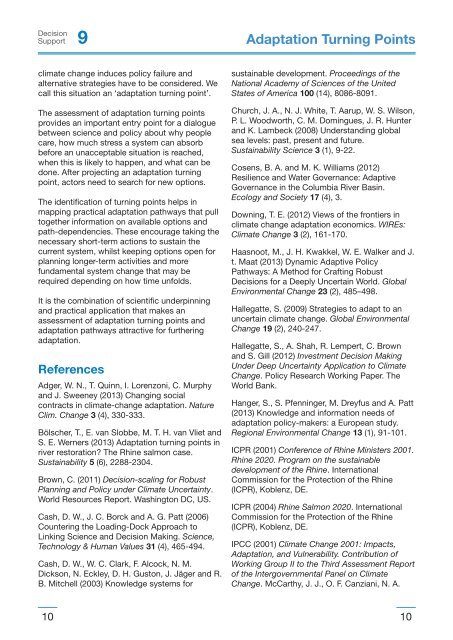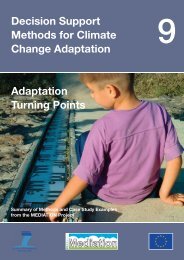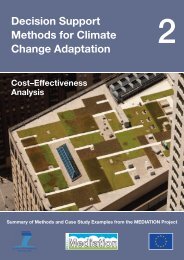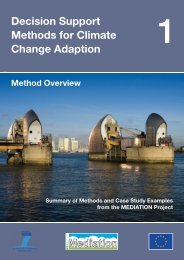Download all Technical Policy Briefing Notes in a single ... - Mediation
Download all Technical Policy Briefing Notes in a single ... - Mediation
Download all Technical Policy Briefing Notes in a single ... - Mediation
- No tags were found...
You also want an ePaper? Increase the reach of your titles
YUMPU automatically turns print PDFs into web optimized ePapers that Google loves.
DecisionSupport 9Adaptation Turn<strong>in</strong>g Po<strong>in</strong>tsclimate change <strong>in</strong>duces policy failure andalternative strategies have to be considered. Wec<strong>all</strong> this situation an ‘adaptation turn<strong>in</strong>g po<strong>in</strong>t’.The assessment of adaptation turn<strong>in</strong>g po<strong>in</strong>tsprovides an important entry po<strong>in</strong>t for a dialoguebetween science and policy about why peoplecare, how much stress a system can absorbbefore an unacceptable situation is reached,when this is likely to happen, and what can bedone. After project<strong>in</strong>g an adaptation turn<strong>in</strong>gpo<strong>in</strong>t, actors need to search for new options.The identification of turn<strong>in</strong>g po<strong>in</strong>ts helps <strong>in</strong>mapp<strong>in</strong>g practical adaptation pathways that pulltogether <strong>in</strong>formation on available options andpath-dependencies. These encourage tak<strong>in</strong>g thenecessary short-term actions to susta<strong>in</strong> thecurrent system, whilst keep<strong>in</strong>g options open forplann<strong>in</strong>g longer-term activities and morefundamental system change that may berequired depend<strong>in</strong>g on how time unfolds.It is the comb<strong>in</strong>ation of scientific underp<strong>in</strong>n<strong>in</strong>gand practical application that makes anassessment of adaptation turn<strong>in</strong>g po<strong>in</strong>ts andadaptation pathways attractive for further<strong>in</strong>gadaptation.ReferencesAdger, W. N., T. Qu<strong>in</strong>n, I. Lorenzoni, C. Murphyand J. Sweeney (2013) Chang<strong>in</strong>g socialcontracts <strong>in</strong> climate-change adaptation. NatureClim. Change 3 (4), 330-333.Bölscher, T., E. van Slobbe, M. T. H. van Vliet andS. E. Werners (2013) Adaptation turn<strong>in</strong>g po<strong>in</strong>ts <strong>in</strong>river restoration? The Rh<strong>in</strong>e salmon case.Susta<strong>in</strong>ability 5 (6), 2288-2304.Brown, C. (2011) Decision-scal<strong>in</strong>g for RobustPlann<strong>in</strong>g and <strong>Policy</strong> under Climate Uncerta<strong>in</strong>ty.World Resources Report. Wash<strong>in</strong>gton DC, US.Cash, D. W., J. C. Borck and A. G. Patt (2006)Counter<strong>in</strong>g the Load<strong>in</strong>g-Dock Approach toL<strong>in</strong>k<strong>in</strong>g Science and Decision Mak<strong>in</strong>g. Science,Technology & Human Values 31 (4), 465-494.Cash, D. W., W. C. Clark, F. Alcock, N. M.Dickson, N. Eckley, D. H. Guston, J. Jäger and R.B. Mitchell (2003) Knowledge systems forsusta<strong>in</strong>able development. Proceed<strong>in</strong>gs of theNational Academy of Sciences of the UnitedStates of America 100 (14), 8086-8091.Church, J. A., N. J. White, T. Aarup, W. S. Wilson,P. L. Woodworth, C. M. Dom<strong>in</strong>gues, J. R. Hunterand K. Lambeck (2008) Understand<strong>in</strong>g globalsea levels: past, present and future.Susta<strong>in</strong>ability Science 3 (1), 9-22.Cosens, B. A. and M. K. Williams (2012)Resilience and Water Governance: AdaptiveGovernance <strong>in</strong> the Columbia River Bas<strong>in</strong>.Ecology and Society 17 (4), 3.Down<strong>in</strong>g, T. E. (2012) Views of the frontiers <strong>in</strong>climate change adaptation economics. WIREs:Climate Change 3 (2), 161-170.Haasnoot, M., J. H. Kwakkel, W. E. Walker and J.t. Maat (2013) Dynamic Adaptive <strong>Policy</strong>Pathways: A Method for Craft<strong>in</strong>g RobustDecisions for a Deeply Uncerta<strong>in</strong> World. GlobalEnvironmental Change 23 (2), 485–498.H<strong>all</strong>egatte, S. (2009) Strategies to adapt to anuncerta<strong>in</strong> climate change. Global EnvironmentalChange 19 (2), 240-247.H<strong>all</strong>egatte, S., A. Shah, R. Lempert, C. Brownand S. Gill (2012) Investment Decision Mak<strong>in</strong>gUnder Deep Uncerta<strong>in</strong>ty Application to ClimateChange. <strong>Policy</strong> Research Work<strong>in</strong>g Paper. TheWorld Bank.Hanger, S., S. Pfenn<strong>in</strong>ger, M. Dreyfus and A. Patt(2013) Knowledge and <strong>in</strong>formation needs ofadaptation policy-makers: a European study.Regional Environmental Change 13 (1), 91-101.ICPR (2001) Conference of Rh<strong>in</strong>e M<strong>in</strong>isters 2001.Rh<strong>in</strong>e 2020. Program on the susta<strong>in</strong>abledevelopment of the Rh<strong>in</strong>e. InternationalCommission for the Protection of the Rh<strong>in</strong>e(ICPR), Koblenz, DE.ICPR (2004) Rh<strong>in</strong>e Salmon 2020. InternationalCommission for the Protection of the Rh<strong>in</strong>e(ICPR), Koblenz, DE.IPCC (2001) Climate Change 2001: Impacts,Adaptation, and Vulnerability. Contribution ofWork<strong>in</strong>g Group II to the Third Assessment Reportof the Intergovernmental Panel on ClimateChange. McCarthy, J. J., O. F. Canziani, N. A.10 10





